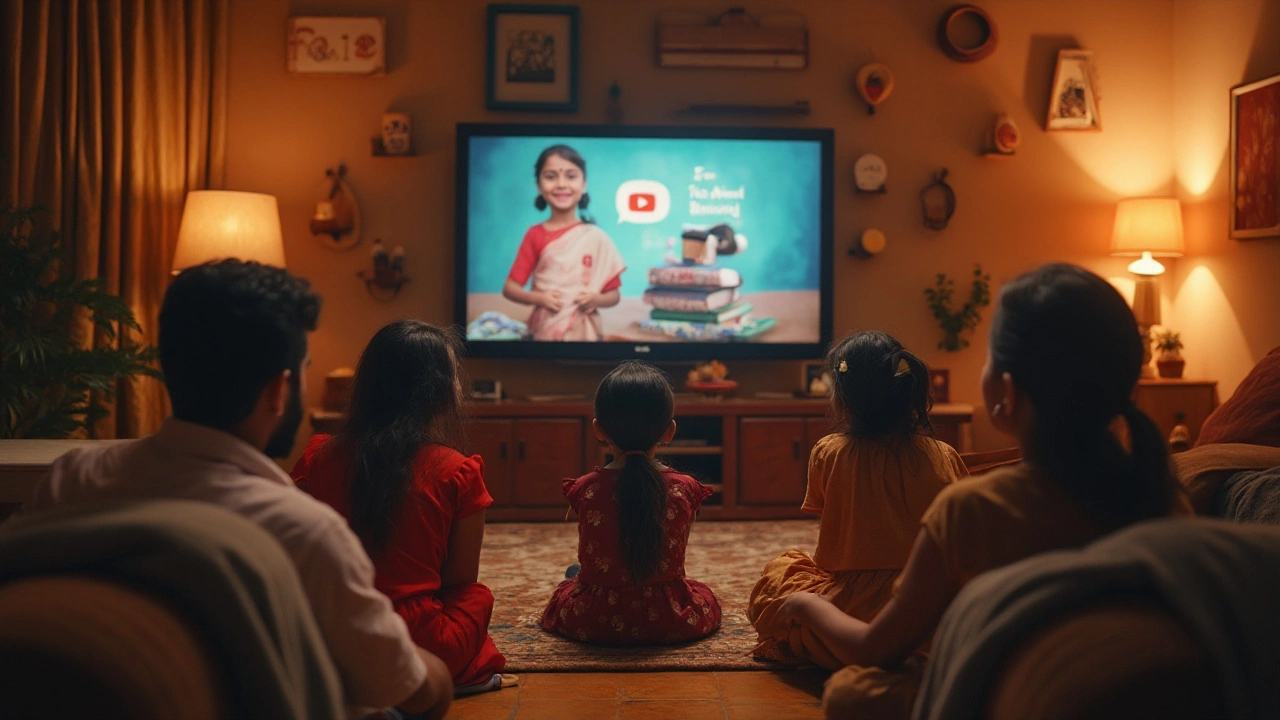
The internet is a sprawling universe of resources for learning spoken English, and YouTube stands out as a dynamic platform where knowledge meets entertainment. However, with thousands of channels out there, it's easy to get lost. Some channels focus on conversational phrases, while others dive deep into grammar essentials, and some even explore cultural nuances through storytelling.
In this guide, we're diving into the must-watch YouTube channels that will not only help you speak confidently but also make language learning an enjoyable journey. Whether you're a beginner looking to grasp the basics, or someone polishing an already decent speaking ability, there's something for everyone. Ready to enhance your English communication skills with engaging content? Let's dive in!
- Choosing the Right Channel
- Top Channels and Their Features
- Using YouTube for Language Practice
- Tips to Optimize Learning
Choosing the Right Channel
When setting out to master spoken English, picking the right YouTube channel can make a world of difference. Not all channels are created alike, and what might be a perfect fit for one learner could feel stagnant to another. It’s critical to understand your own learning style and preferences before diving into the vast ocean of content available online. Some learners thrive with interactive content that invites them to participate, while others prefer structured lessons that mimic classroom-like teaching methods. Ask yourself: do you learn better with visuals, real-life contexts, or perhaps storytelling?
Consider channels that offer side-by-side subtitles or captions in both English and your native language. This feature can greatly assist in grasping unfamiliar terminology without leaving you frustrated. Pay attention to the engagement level of the channel’s host, too. A cheerful, engaging presenter can keep you motivated, even through complicated lessons. One YouTuber, for example, often acknowledges that language learning is challenging, stating, "The key isn't to be perfect, it's to keep improving," which can be reassuring to viewers who might otherwise feel discouraged by their progress.
Moreover, review the feedback and comments left by other subscribers. This feedback can give you insight into the efficacy of the channel's methods. Look for channels that actively respond to viewers' comments, as this interaction often leads to a more enriched learning experience. A good starting point is to check the Channels section of YouTube’s Edu category, where established channels such as EnglishClass101 and BBC Learning English regularly produce quality content. These channels conveniently group lessons into playlists, categorizing by proficiency levels from beginner to advanced.
Additionally, your choice should be influenced by the channel’s consistency. Regular uploads suggest a commitment to content quality and provide fresh learning materials to satisfy different learning paces. It's worth noting that some channels orchestrate live sessions, granting you the opportunity to interact directly with instructors. If you’re lucky, you might even catch channels that leverage AI technology to tailor lessons that address your specific weak points based on your viewing behaviors.
Another layer to consider is the cultural context. A truly great spoken English channel incorporates cultural insights. This context not only enriches your vocabulary but enhances your understanding of language nuances in real-world scenarios. In a globalized world, knowing idiomatic expressions or cultural references can set you apart. An interesting fact is that channels focusing on cultural intelligence tend to have higher viewer retention rates, possibly due to the intrinsic motivation that these real-world connections evoke.
As you navigate the numerous channel options, remember that flexibility is key. Feel free to switch channels if one doesn’t resonate. Languages are living, evolving forms of communication, and your learning journey should mirror this by being dynamic and adaptable. Explore, experiment, and enjoy the rewarding experience of enhancing your spoken English skills with YouTube!

Top Channels and Their Features
When it comes to learning spoken English through YouTube, there are some channels that have clearly stood out from the crowd. One of the leading channels is Rachel’s English, which is particularly famous for its deep focus on American pronunciation. Rachel, a seasoned expert, offers a wealth of content, from conversational skills to subtle pronunciation nuances, often using real-life scenarios. Her engaging style helps learners grasp the intricacies of American English, making the journey not just educational but also enjoyable. Additionally, her videos often include connected speech lessons, which are invaluable for understanding native speakers at natural speaking speeds.
There's also the vibrant channel called EnglishClass101, which brings a systematic approach to language learning. It's known for a mixture of video and audio content that caters to different learning styles. What’s unique here is their “word of the day” feature that piques curiosity and encourages daily learning. With hosts who are both informative and personable, learners find themselves tuning into lessons that naturally enhance their vocabulary and grammar. Moreover, the channel delves into cultural lessons, which provides a holistic language learning experience that goes beyond textbooks.
“Language is the road map of a culture. It tells you where its people come from and where they are going.” — Rita Mae Brown
If you’re looking for something that focuses on British English, then BBC Learning English is the channel you want to be on. It is famed for its structured courses tailored to various proficiency levels. What makes this channel exceptionally useful are its real-world videos where English is used in everyday situations, helping learners acclimate to practical conversations. The video playlists cover everything from English slang to formal speech, opening up a window into the blend of language forms used in the UK.
VOA Learning English is another standout, especially noteworthy for learners seeking to improve their spoken English while staying informed about global news. This channel uses a simplified American English approach, which is ideal for beginners and intermediate learners. The videos often incorporate slow and clear speech without compromising the richness of content, making it easier for listeners to catch new vocabulary. With this channel, learners not only enhance their English but also stay abreast of world events.
For those interested in quick, bite-sized lessons, the Learn English with TV Series channel offers a creative and contemporary method. By dissecting popular TV series and movies, this channel provides learners with engaging content that captures the nuances of real-life conversation styles. This approach makes it fun and effective to learn phrasal verbs, idioms, and slang, ensuring that the journey of learning English is as fascinating as the shows themselves.
Below is a brief comparison of features from some of these channels:
| Channel Name | Focus Area | Special Feature |
|---|---|---|
| Rachel’s English | American Pronunciation | Real-life Scenarios |
| EnglishClass101 | Grammar & Vocabulary | Word of the Day |
| BBC Learning English | British English | Structured Courses |
| VOA Learning English | News and Learning | Simplified English |
| Learn English with TV Series | Conversational Skills | Phrasal Verbs via TV Shows |
In this digital age, where learning has largely moved online, these YouTube channels present a valuable opportunity to improve spoken English skills from the comfort of your own home. Each offers a unique blend of teaching styles and content, allowing learners to choose which method aligns best with their learning preferences.

Using YouTube for Language Practice
Practicing a new language like English requires a blend of consistency, exposure, and active engagement. Nowadays, YouTube has changed the game in language learning by providing access to high-quality content that caters to diverse learning styles. One of the best features of videos is the ability to listen to native speakers use spoken English naturally. This is an effective way to train your ear and improve pronunciation.
To optimize your learning, consider watching a video entirely to get the general context and then rewatch, focusing on different elements such as sentence structure or vocabulary. Try pausing after sentences to repeat as accurately as possible. This mimicking exercise helps to build both confidence and conversational rhythm. By actively engaging with these videos, you grasp nuances better than passive learning from a textbook.
A particularly effective strategy is interleaving – combining various videos on similar topics from different YouTube channels. This helps reinforce what you learn by showing how different presenters urvince certain phrases, or explain similar concepts. Try creating a mix of tutorial videos, interviews, and cultural stories. Exposure to a variety of accents and speaking speeds refines listening skills, critical for real-world conversations.
According to linguist Stephen Krashen, "Acquisition requires meaningful interaction in the target language - natural communication - in which speakers are concerned not with the form of their utterances but with the messages they are conveying and understanding."This idea highlights the importance of interaction, which YouTube provides in a unique way. In comments or live streams, you can ask questions and become part of a community, essentially creating a space where practice goes beyond just listening.
Don't overlook the power of playlists and subscriptions. They allow you to organize your learning path, ensuring you don’t miss crucial lessons. Channels often structure their content progressively, allowing you to build skills step-by-step. Consider engaging with channels that challenge you periodically. Some channels offer quizzes at the end of their videos or propose activities – these actionable insights solidify learning and keep the process lively, turning passive watching into active practicing.
If you're data-driven, here's a small insight: a study published by the Impact of Education found that students using multimedia resources for language learning effectively retained up to 30% more language skills than those using traditional methods.
Finally, consistency is key. Even with the flexibility of online learning, a dedicated schedule that incorporates daily or weekly YouTube sessions can make a significant difference. It's amazing how dedicating just 15-30 minutes each day can lead to remarkable improvements in your language abilities. The important part is to enjoy the journey, be curious about the stories, the culture, and the language itself.

Tips to Optimize Learning
When it comes to learning spoken English effectively through YouTube, it's not just about clicking on every YouTube channel you find and binge-watching countless tutorials. To truly optimize language learning, you need a strategic approach. Start by setting clear, realistic goals for your English proficiency. Whether it's improving your pronunciation, expanding your vocabulary, or mastering idiomatic expressions, having a target gives direction to your learning efforts.
Create a routine that allows you to engage with your chosen videos daily. Consistency is vital in language acquisition, so dedicating a specific time each day to your learning can significantly boost retention. It's like exercise for your brain – the more you practice, the stronger your skills become. Combine this with active listening, repeating out loud what you hear in the videos, which can drastically enhance your speaking abilities.
Engage with the community. Many of the top spoken English channels have vibrant communities in their comment sections or even dedicated forums where you can practice with other learners, share tips, and gain new insights. This interaction edifies your comprehension and helps you apply what you've learned in a collaborative environment. Aiding your memory and understanding, social interaction is a proven method to embed new knowledge.
According to linguist and author Stephen Krashen, "Acquisition requires meaningful interaction in the target language – natural communication."
Keep track of your progress. It's useful to maintain a learning journal or digital planner where you can jot down new words, phrases, and grammar rules you've learned. Reflect on what you've practiced by summarizing your thoughts in English. This active recall helps solidify your knowledge and pinpoints areas where you need more practice.
Don't shy away from technology. Use language learning apps in conjunction with YouTube to test your skills and receive instant feedback. Platforms like Duolingo and Memrise can be great companions, providing interactive ways to reinforce the concepts learned through video. Consider using subtitles in your native language and then English, gradually shifting to English-only to boost immersion.
For those aiming to accelerate their learning, consider joining online challenges or contests hosted by these channels. Such events not only offer new content to learn but also put your skills to the test. They can be a rewarding way to elevate your learning experience.
| Strategy | Effectiveness |
|---|---|
| Daily Routine | High |
| Community Interaction | High |
| Progress Tracking | Moderate |
| Technology Integration | High |
| Participation in Challenges | Moderate |





